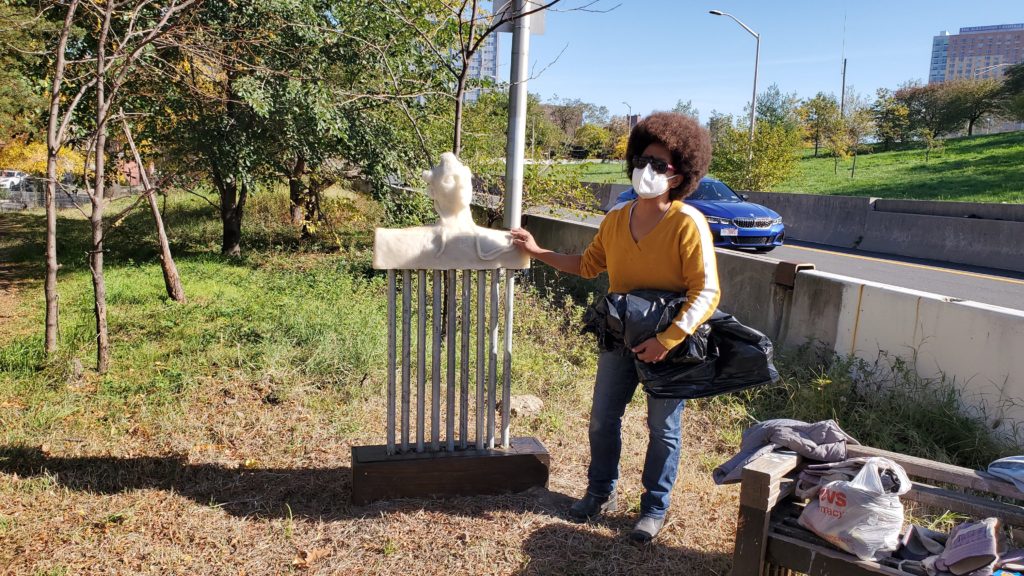On November 7th, a group of community members joined artist and founder of the Elmhurst Sculpture Garden, Yvonne Shortt, on a thorough clean-up of the space, and an unveiling of her latest piece at the public community site, which is located behind the Olive Garden Restaurant at 92nd Street and 59th Avenue, adjacent to the L.I.E Exit. Ms. Shortt is a familiar name to residents of Western Queens, as she has done numerous outdoor projects in past years, all designed to stimulate interactions and provoke thought in positive ways for the communities she has served.
These public art installations are a process, not simply a placement of a finished piece, because they require grittiness, a hands-digging-into-the-earth approach, and a physical touching up of the areas around them to showcase the works. The Elmhurst Sculpture Garden was founded in 2017, along with artist Mayuko Fujino, and has been a much welcome addition to the neighborhood, which cries for more green space, encroached by so much development, blotting out both land and sky. “I chose spaces near where I’ve lived or worked or have some connection to. Art is a tool to ask questions, learn about the community, and take action on issues,” said Ms. Shortt, who spends her time these days commuting from her studio and living space in Rego Park, to a converted barn studio where she stays upstate, which she has during much of these Covid-19 months.
The Elmhurst Sculpture Garden (ESG) was in dire need of a new sprucing up, as in recent times, it has seen a buildup of refuse, and some bothersome effects on the projects, which are revolving. The area needs a continuous set of eyes for maintenance and upkeep, and in the current new normal, making a schedule is difficult.
“ESG was another example that was run down and dirty when we began in 2017. Community art is different than public art. It’s for every-day people to engage. It’s for people to take ownership in this created space; and just do it. Come by with a bag, alone or with a group during your free time. I am not the gatekeeper. I’m just a steward,” continued Ms. Shortt.
A dozen or so people came to assist with the cleanup, wearing durable gloves, using rakes, and placing a host of discarded items in hefty bags which were then left at a designated sanitation disposal spot. In less than an hour and a half, the before and after look of the site showed remarkable change. One community participant, architectural designer Kelly Li commented,
“I think it’s crucial for people to have a common purpose in order to feel a sense of ownership and responsibility for spaces within their community. When we each feel connected to these spaces, we become stewards of them, and interact with others who feel the same can create mutually beneficial relationships. Art speaks to people viscerally and provides an entry point for people to ask questions or get involved by bringing attention to places that are otherwise overlooked. Elmhurst Sculpture Garden creates a respite of green, pedestrian space in an otherwise car-heavy area.”
Once the cleanup aspect was completed, Ms. Shortt unveiled the newest addition to the ESG (photo, top), which she calls Afro-Pick: Bantu Knots and the Underground Railroad; a sculpture made of marbleized stone, steel, and wood, and is part of an African-American themed series. “When I decided to design it, it also paid homage to Elmhurst, picks were ornate, beautiful, and hand carved. My initial rendering was of an idea to continue to bring awareness that this free group of African-Americans once lived in the community. Part of the reason for putting it in Elmhurst was to be close to the burial ground, to help draw more attention to it, and bring more attention to the churches; not to be so political.” (Elmhurst’s African American burial ground behind 90-56 Corona Ave and 47-11 90th Street was rediscovered in October 2011, with the uncovering of the ‘Iron Coffin Lady,’ believed to be Martha Petersen. She was dressed in stockings, a chemise, a gown, and included with her was a lovely hair pick showing she was a much cared for member of the community. She passed away in 1851 of smallpox at the age of 27. At current writing, an archaeological team from the Chrysalis firm, is working diligently at the site, and has discovered more remains. Chrysalis was hired by the developer who has reached an agreement with St. Mark’s AME church, now based in Jackson Heights, and plans to place a memorial on site in addition to a residential building.) “The way the head is placed on the beam pays respect to the ancients, giving an impression of trauma, but perseverance. The plan is to unite this theme for all nationalities and ethnicities. This space is for all of us to unite and come together regardless of nationality or politics,” summed up Ms. Shortt. The ESG space will continue to draw on artists to submit work and address social issues and problems. The space continues to evolve and will hopefully expand in the future. Newtown Civic member and clean up participant Luis Loli said, “This green space and the sculptures co-exist here in perfect harmony.”




